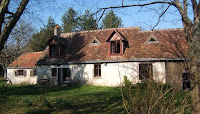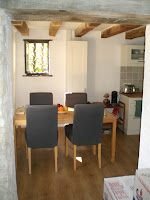| directions in Cenan |
Earlier this month Charnizay was 'en fete'. We wrote about it here. It was then that we met M. Piveau, one of the stalwarts of the local historical association, or 'L'Association de Charnizay, son Passé et la Nouvelle-France' to give it its proper title. The association had set up some very interesting displays in the village library and we were especially intrigued by the one on Acadiens in Poitou.
To find the villages where the Acadiens were re-settled go south on the D3 from La Roche Posay to Pleumartin and on to Archigny. They settled an area which today corresponds to the villages of Archigny, Les Huit Maisons, Cenan, La Puye and la Ligne acadienne. Last Sunday we went and had a look round.
 |
| 1677 Map, Acadie is just above-left of the crown |
Charnizay has a connection with Acadie, one of the original French colonies in Canada.
Charles de Menou d'Aulnay, a member of the noble family who held the manor of Charnizay went out to Acadie, what we now know as Nova Scotia, Canada in 1632. He became the Governor and helped turn Port Royale into the main town.
The colonies in North America were keenly contested, mirroring the frequent conflicts in Europe between France and England during the 17th and 18th centuries. The 1632 expedition sent out by Louis XIII of which Menou was a leading member had been sent to "re-Frenchify" the area after England returned it to French control following the Treaty of St Germain en Laye. [The English had siezed the area in 1629]
In 1713, the Treaty of Utrecht gave control of Acadie and Terre- Neuve to England. The French government wanted the colonists to leave Acadie and move to the remaining French colonies of Ile Royale and Ile St Jean [modern day Cap Breton Island and Prince Edward Island].
Many Acadiens weren't keen as the land on the two islands was of much poorer quality. The English thought that it might prove useful for English Acadie to keep them. These Acadiens, who remained were happy to stay as "neutral French". In other words they were happy to promise not to bear arms against either France or England; however, they weren't willing to sign an oath of allegiance to the English crown.
| house no 31 la Ligne acadienne |
Between September and December 1755 all the Acadiens were arrested and deported--some 14 ships carried 5,000 Acadiens into exile. In the December another 1800 [Acadien] prisoners from Port Royale and 600 recaptured escapees were also dispatched. They were resettled in the English colonies in North America. The colony of Virginia refused to accept their quota of 1500 deportees--all from the region of Grand Pré, so these deportees were sent to England.
During the Seven Year's War [1756 - 63] the English gained control of the fortress of Louisbourg, Ile Royale, and Ile St Jean and their inhabitants were also shipped to England or sent directly to various ports in France like La Rochelle, Brest, or St Malo. Similar deportations continued right up until the Treaty of Paris in 1763.
The ports of Brittany and northern France were full of Acadien refugees. During the months of May and June 1763 the last wave of refugees arrived in France. They were the Acadiens who had been deported to England. They had refused to return to what was now Nova Scotia as they considered themselves to be French and not subjects of the English crown.
This left Louis XV with a real problem. His ports were awash with destitute and unemployed Acadiens. They were given a pension of 6 sols per day but the port authorities were responsible for housing, medical care and looking after the old and infirm. No one was happy with the state of affairs so the French state had to look for a solution.
| house no 36 la Ligne acadienne |
It took years of to-ing and fro-ing, and of politicking. Many different proposals were put forward to re-settle the Acadiens in various different locations in France; mainly in places where the land had been abandonded as a result of successive conflicts. There were plans to re-settle the Acadiens around Amboise, in Lorraine, on Corsica. Some families were settled on Belle-Ile-en-Mer off Brittany but hardship meant that of the 77 families who went out only 16 stayed; the others gave up. None of the other schemes came to anything.
By 1770 the Acadiens were becoming impatient. If they emigrated --and some did -- in large numbers [to Louisiana & New Brunswick] it meant that France would lose face in front of Spain and England.
Step forward a nobleman from Poitou, the Marquis de Pérusse des Cars. He offered a face saver--land to resettle 1500 Acadiens. The plan was to create 5 villages, each composed of 30 farms; 10 people per farm. A huge project, it meant that houses had to be built; communities created and infrastructure established--after all there was nothing on site.
All this took time, quite a bit of time. In the end the houses were built differently to the local traditional style as it was taking too long to quarry the needed stone and get it on site. The Marquis had an expert fetched from Normandy to show the masons how to build cob walls. The first 15 houses were completed in 1773. Each farmhouse had a large room which served as both kitchen and living room, a bedroom, a celler, a stable, a barn and a well. Each farm was given 17 hectares, 2 bullocks, 2 cows,and a wagon.
| Cenan |
In July 1774 about 1,472 Acadiens were lodged in temporary accomodation in Chatellerault. By the end of the year they most were moving in and beginning to form communities. For some the wait had been almost 20 years.
You can visit a restored farmhouse in the village of Les Huit Maisons [opening hours summer mostly] and original houses along la Ligne acadienne are marked with a plaque.








